外研版八年级英语上册教案
- 格式:docx
- 大小:3.73 KB
- 文档页数:3

外研版初中英语八上全册教案及导学案初二英语(上)Module 1 Unit 1 教学设计教材分析:Unit 1通过听、读、说训练,初步学习给别人提建议的方法。
其中活动1要求将所给表示学习活动的词汇分类;活动2要求根据录音判断对话主题;活动3—5听读包含建议的对话并完成填表、答问等任务。
活动6学习英语中的连读法;活动7根据提示口头练习给别人提建议的方法。
教学目标:To get to know the key vocabulary.To understand the dialogue 3.To be able to talk about the problems in learning English.教学重点:Key points: translate, correct, grammar, pronunciation, spelling, try to do,Why don’t you…? How about…?教学方法Listening and speaking.教具准备Tape recorder教学流程Grade8 Module1 Unit2达标题:一.Complete the sentences with the next words.Check correct improve match number1.______your English by listening to the radio.2.______the pictures in the order you hear them.3.______the mistakes in these sentences.4._______the pictures with the paragraphs.5._______ your spelling and punctuation.二.完成单词1.You should practice more to i ___________ your English.2.Can you c_________ to 100 in English.3.Don’t f_________ to turn off the English when you leave the room .4.I can’t r__________ all the new words .5.Can you t__________ this word .I don’t understand it.6.R__________ the correct answer.Unit 3 Language in use 教学设计贾建芝教学目标To encourage students to write an English study plan for themselves this year.To say what they’re good at, what they aren’t good at and what they should do.教学重点Focus: Why don’t we …?How about…?You should do ….It is + adj. + to do ….设计思路Present a practical task for the students to learn language in use.Teaching stepsWarming-up教师活动1.Ask the Ss to retell the text in Unit 2. Choose one question to retell2.Ask the Ss “ How to learn English?” and let them to discuss in groups and presenttheir answers.(也可以My ways to learn English为题演讲)学生活动 1.Try to retell the text.2.Discuss in groups and show the answers in front of the class.(2 minutes to prepare ,then give a speech.)In-put教师活动Read and learn the useful sentences in Language in use.You should …Why don’t you….?It’s + adj. + to do sth.学生活动Read loudly and try to understand the meaning of every sentence ,then use them to make some sentences.Practice 1.Listening practice.Play the tape and finish off part 1 and 2.2.Show six pictures. Ask them to talk about them and say if Jack is a goodstudent.(work in pairs.)3.Ask the Ss to give advice to Jack.4.Ask them to work in pairs and read the problem and give advice.(work in groups,each student answer two problems.)5.Ask them to finish part 6-9Practice1. -What are you doing ? -I _____________( play ) football.2. Today is my sister's birthday. She is __________ (cut) her birthday ake now.3. Li Ming _______( have ) five lessons every day.4. He ___________( visit ) his grandfather in Nanning this weekend.5. Leny comes from India. He is ___________(India).6. I will take some _________(photo) in Lingshui Lake.7. On Sunday morning I will help my mother ___________(make) the lunch.8. Jenny will practise ___________(play) the piano this afternoon.9. Would you like __________ (have) a cup of tea?10. I hop you'll enjoy ____________(go) to your grandparents' farm.Out-putAsk students to present their thinking and their English study plan and finish off part 10-12.Make an English study plan for themselves for this year, then read it in front of the class. Summary The difficulties of this unit.Homework 1.Write the new words ten times.2.Write an English study plan.教学反思It’s hard to improve the students’ writing skill. Some students need help.达标题一、单项选择:( ) 1.-Where are you from?-I am from______.A. ChineseB. AmericanC. JapaneseD. America( ) 2.-What's your favourite_____?-It's Maths.A. teacherB. subjectC. foodD. drink( ) 3. I have English, Maths, Chinese and Physics _____ Monday orning.A. onB. inC. atD. to( ) 4.-Can I ask you _____ questions____ a survey ?-Sure.A. any, forB. some, forC.a, toD. an, of( ) 5. He is good at _______ football .A. playB.plaiingC.playingD.plays( ) 6. I like Physics,____Maths is my favourite !A.andB.soC.orD.but( ) 7. Will you do ________ for National Day holidays.A. something specialB. special somethingC. anything specialD. special anything( ) 8. He is looking forward to _______ the famous singer.A. seeB. seesC. seeingD. saw( ) 9.Don't forget _______the flowers when I leave.A.to waterB.waterC.wateringD.waters( ) 10.It will _____ me half an hour to go to school on foot.A.spendB.payC.costD.take( ) 11.I hope you 'll enjoy____here with us.A.liveB.livesC.livingD.to live( ) 12.-_____Tom come to your party this evening ?-I am not sure.A.WasB.AreC.IsD.Will( ) 13.Li Ming often helps me ____ my homework on the weekends.A.withB.onC.inD.about( ) 14.-What will you do in Hong Kong ?-I am not sure. _____ I'll see some famous sights.A.MayB.May beC.MightD.Maybe( ) 15. My brother is too _________ to go to school.A. smallB. youngC. bigD. old二、词形变换,用括号中单词的正确形式填空(20分)1. -What are you doing ? -I _____________( play ) football.2. Today is my sister's birthday. She is __________ (cut) her birthday ake now.3. Li Ming _______( have ) five lessons every day.4. He ___________( visit ) his grandfather in Nanning this weekend.5. Leny comes from India. He is ___________(India).6. I will take some _________(photo) in Lingshui Lake.7. On Sunday morning I will help my mother ___________(make) the lunch.8. Jenny will practise ___________(play) the piano this afternoon.9. Would you like __________ (have) a cup of tea?10. I hop you'll enjoy ____________(go) to your grandparents' farm.Module 2 ExperiencesUnit 1 Have you ever entered a competition?贾建芝题材内容:本模块的语法为现在完成时,内容主要涉及经历。
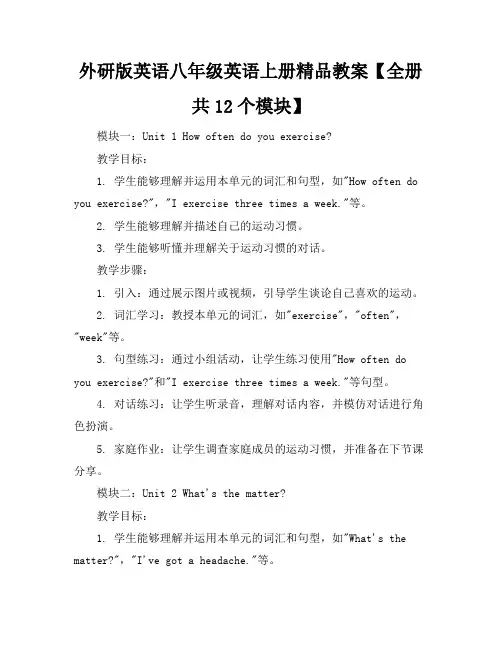
外研版英语八年级英语上册精品教案【全册共12个模块】模块一:Unit 1 How often do you exercise?教学目标:1. 学生能够理解并运用本单元的词汇和句型,如"How often do you exercise?","I exercise three times a week."等。
2. 学生能够理解并描述自己的运动习惯。
3. 学生能够听懂并理解关于运动习惯的对话。
教学步骤:1. 引入:通过展示图片或视频,引导学生谈论自己喜欢的运动。
2. 词汇学习:教授本单元的词汇,如"exercise","often","week"等。
3. 句型练习:通过小组活动,让学生练习使用"How often do you exercise?"和"I exercise three times a week."等句型。
4. 对话练习:让学生听录音,理解对话内容,并模仿对话进行角色扮演。
5. 家庭作业:让学生调查家庭成员的运动习惯,并准备在下节课分享。
模块二:Unit 2 What's the matter?教学目标:1. 学生能够理解并运用本单元的词汇和句型,如"What's the matter?","I've got a headache."等。
2. 学生能够理解并描述自己的健康状况。
3. 学生能够听懂并理解关于健康问题的对话。
教学步骤:1. 引入:通过展示图片或视频,引导学生谈论健康问题。
2. 词汇学习:教授本单元的词汇,如"matter","headache","toothache"等。
3. 句型练习:通过小组活动,让学生练习使用"What's the matter?"和"I've got a headache."等句型。
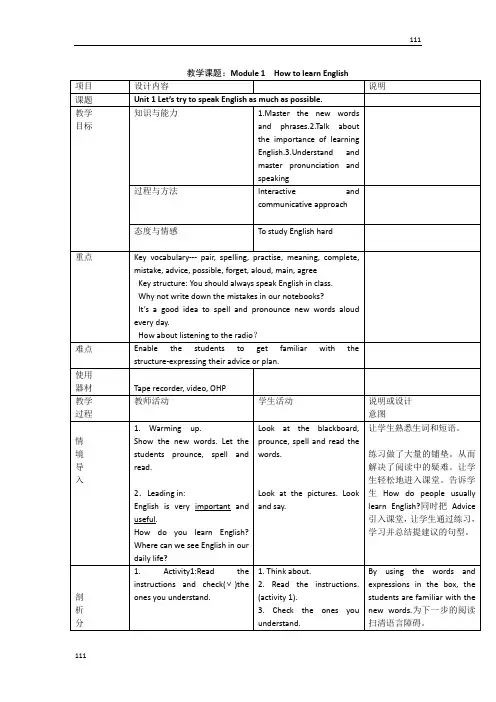
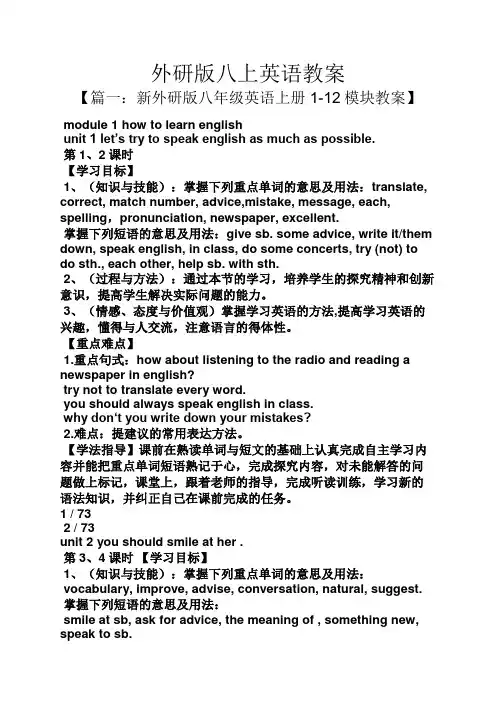
外研版八上英语教案【篇一:新外研版八年级英语上册1-12模块教案】 module 1 how to learn englishunit 1 let’s try to speak english as much as possible.第1、2课时【学习目标】1、(知识与技能):掌握下列重点单词的意思及用法:translate, correct, match number, advice,mistake, message, each, spelling,pronunciation, newspaper, excellent.掌握下列短语的意思及用法:give sb. some advice, write it/them down, speak english, in class, do some concerts, try (not) to do sth., each other, help sb. with sth.2、(过程与方法):通过本节的学习,培养学生的探究精神和创新意识,提高学生解决实际问题的能力。
3、(情感、态度与价值观)掌握学习英语的方法,提高学习英语的兴趣,懂得与人交流,注意语言的得体性。
【重点难点】1.重点句式:how about listening to the radio and reading a newspaper in english?try not to translate every word.you should always speak english in class.why don‘t you write down your mistakes?2.难点:提建议的常用表达方法。
【学法指导】课前在熟读单词与短文的基础上认真完成自主学习内容并能把重点单词短语熟记于心,完成探究内容,对未能解答的问题做上标记,课堂上,跟着老师的指导,完成听读训练,学习新的语法知识,并纠正自己在课前完成的任务。
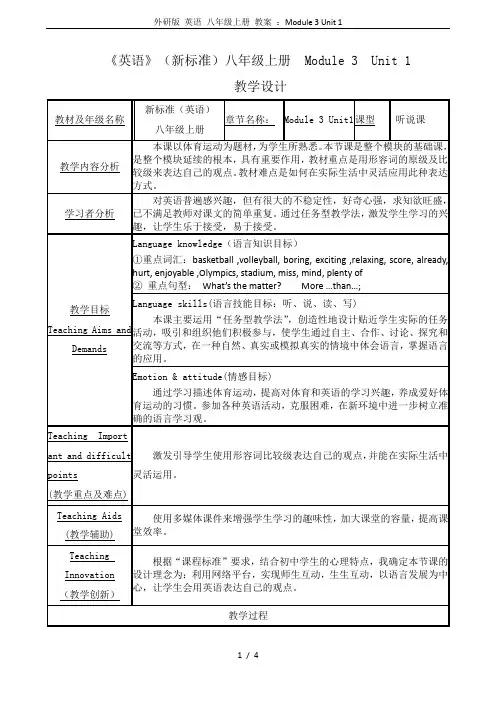
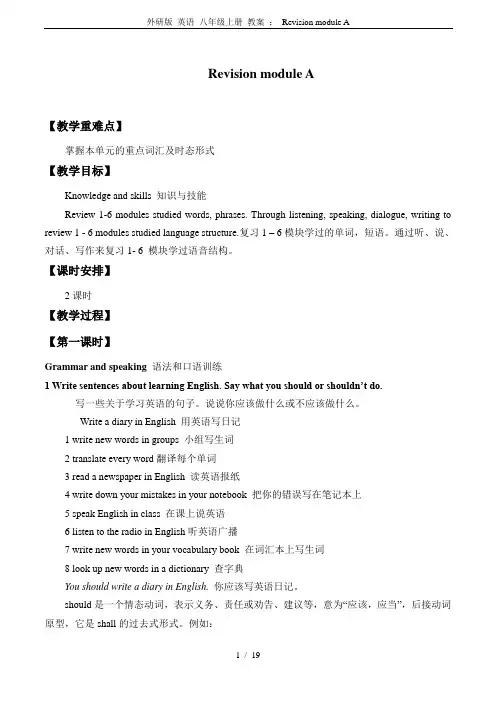
Revision module A【教学重难点】掌握本单元的重点词汇及时态形式【教学目标】Knowledge and skills 知识与技能Review 1-6 modules studied words, phrases. Through listening, speaking, dialogue, writing to review 1 - 6 modules studied language structure.复习1 – 6模块学过的单词,短语。
通过听、说、对话、写作来复习1- 6 模块学过语音结构。
【课时安排】2课时【教学过程】【第一课时】Grammar and speaking 语法和口语训练1 Write sentences about learning English. Say what you should or shouldn’t do.写一些关于学习英语的句子。
说说你应该做什么或不应该做什么。
Write a diary in English 用英语写日记1 write new words in groups 小组写生词2 translate every word翻译每个单词3 read a newspaper in English 读英语报纸4 write down your mistakes in your notebook 把你的错误写在笔记本上5 speak English in class 在课上说英语6 listen to the radio in English听英语广播7 write new words in your vocabulary book 在词汇本上写生词8 look up new words in a dictionary 查字典You should write a diary in English. 你应该写英语日记。
should是一个情态动词,表示义务、责任或劝告、建议等,意为“应该,应当”,后接动词原型,它是shall的过去式形式。
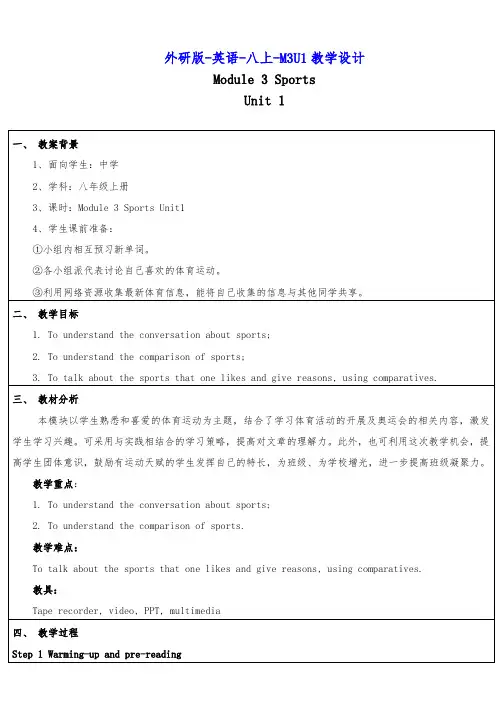
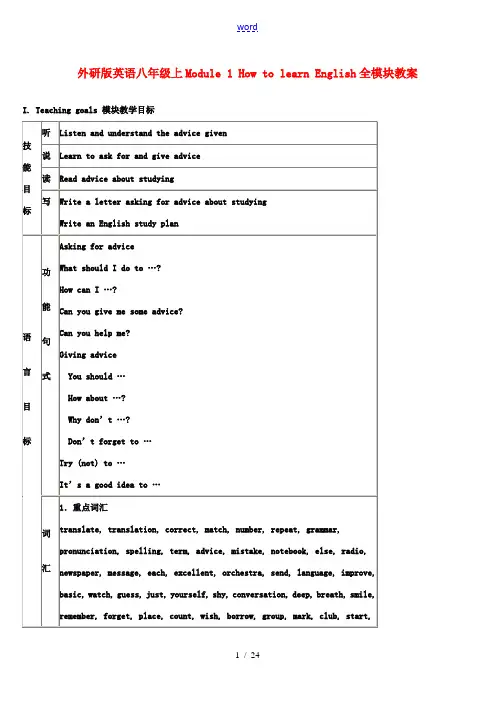
外研版英语八年级上Module 1 How to learn English全模块教案I. Teaching goals 模块教学目标II. Teaching material analyzing 教材分析本模块以“How to learn English”为话题,以学习征求建议、提出建议的方法为主线,介绍了单词分类记忆、根据上下文判断词义;听力细节辨认、反向推理;略读等学习方法。
通过模块学习,学生除了能掌握上述英语学习方法之外,还可以根据同学的建议制定更适合自己的学习计划;同时,模块也复习了一般现在时、现在进行时、一般过去时、一般将来时的用法。
Unit 1 通过听、读、说训练,初步学习给别人提建议的方法。
其中活动1要求将所给表示学习活动的词汇分类;活动2要求根据录音判断对话主题;活动3—5听读包含建议的对话并完成填表、答问等任务。
活动6学习英语中的连读法;活动7根据提示口头练习给别人提建议的方法。
Unit 2 通过读、写训练,学会向别人征求建议或给别人提出建议。
其中活动1要求学生列举自己在语言学习活动中遇到的实际困难。
活动2—4要求学生阅读一语言学习“问答专栏”中内容后完成补全句子、回答问题等练习。
活动5—6要求学生根据自己的学习实际,完成一封求助信并征求同学的建议。
Unit 3 对“提供学习建议”的功能项目进行综合训练,并在此基础上完成制定学习计划的任务。
其中活动1、2 要求听取Charlie和Mary的对话,选出所听到的表示建议的句式并完成问答练习。
活动3—5 要求根据所供图片,描述、评论Jack的学习、生活情况,并根据提示问题提出建议。
活动6要求阅读 Helen的问题并用所供表达完成Simon 的回信。
活动7—9是词汇的拓展训练:其中7要求根据图片写出单词;8用所供词汇组成短语;9用所供词汇完成句子。
Around the world给学生介绍了通过多种渠道学习英语的方法。
Module task要求学生反思自己的英语学习,通过图标明晰信息,并根据图标信息制定学习计划;然后小组交流,提出修改建议。

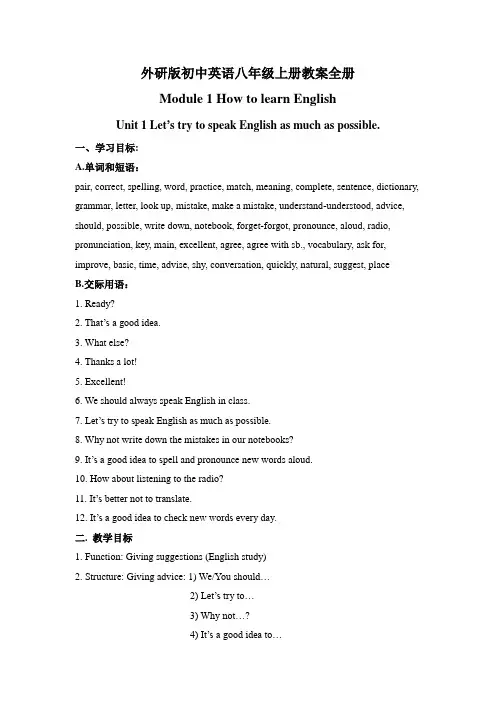
外研版初中英语八年级上册教案全册Module 1 How to learn EnglishUnit 1 Let’s try to speak English as much as possible.一、学习目标:A.单词和短语:pair, correct, spelling, word, practice, match, meaning, complete, sentence, dictionary, grammar, letter, look up, mistake, make a mistake, understand-understood, advice, should, possible, write down, notebook, forget-forgot, pronounce, aloud, radio, pronunciation, key, main, excellent, agree, agree with sb., vocabulary, ask for, improve, basic, time, advise, shy, conversation, quickly, natural, suggest, placeB.交际用语:1. Ready?2. That’s a good idea.3. What else?4. Thanks a lot!5. Excellent!6. We should always speak English in class.7. Let’s try to speak English as much as possible.8. Why not write down the mistakes in our notebooks?9. It’s a good idea to s pell and pronounce new words aloud.10. How about listening to the radio?11. It’s better not to translate.12. It’s a good idea to check new words every day.二. 教学目标1. Function: Giving suggestions (English study)2. Structure: Giving advice: 1) We/You sh ould…2) Let’s try to…3) Why not…?4) It’s a good idea to…5) How about…?6) Why don’t we/you…?7) It’s better not to…3. Skills: 1) Listening and understanding familiar topics (English study).2) Talking about problems in English study and giving advice, conductingconversations in several turns.3) Reading and finding specific information about English study.4) Drafting a letter asking for advice about English study, revising throughpair discussion..4. Around the world: English online5. Task: Writing your English study plan.三、重点及难点:Giving advice: 1) We/You should…2) Let’s try to…3) Why not…? 4) It’s a good idea to…5) How about…? 6) Why don’t we/you…? 7) It’s better not to…四、教学设计:Unit 1 Let’s try to speak English as much as possible.ⅠTeaching modelListening and speakingⅡTeaching methodPWP approachⅢTeaching aims1. To understand conversations involving advice on learning English.2. To get information about how to learn English from the conversation.3. To understand the way of giving advice.4. To practise giving advice on English learning.ⅣTeaching Objectives1. Key vocabulary: pair, correct, spelling, word, practice, match, meaning, complete,sentence, dictionary, grammar, letter, look up, mistake, make amistake, understand-understood, advice, should, possible, writedown, notebook, forget-forgot, pronounce, aloud, radio, key, main,excellent, agree, agree with sb., vocabulary2. Key structures: 1) We/You should…2) Let’s try to…3) Why not…? 4) It’s a good idea to…5) How about…? 6) Why don’t we/you…? 7) It’s better not to…ⅤTeaching aidsTape recorder, OHP , videoⅥTeaching StepsStep 1 Warming up1. Show some pictures of school things. Say how to learn English well.2. Read the words after the teacher.3. Introduce the new words.4. Learn the new words.Step 2 Read and check.1. Read the instructions in Activity 1and check(√) the ones you understand.1) Work in pairs. Ask and answer the questions.2) Correct the spelling.3) Listen and check the words you hear.4) Practise saying the words.5) Match the words with the meaning.6) Complete the sentences with the words in the box.3. Ask the students to check their answer with a partner.4. Call back the answer from the whole class and check the answer.Step 3 Listen and repeat.1. Ask the students to read the word and expressions in Activity2.dictionary grammar letter look up make a mistake meaning understand 2. Read through the questions.1) Which word did Daming not understand?2) What mistake did Lingling make?3) How does Daming usually check the spelling of a word?4) Why is it difficult for Daming to check the spelling of cinema?3. Play the recording and ask the students to listen to the recording carefully.4. Listen and answer the questions. Use the words and expressions from the box.5. Play the recording again, then they can check their answer with a partner.6. Call back the answer from the whole class and check the answer.Step 4 Listen and read.1. Show some pictures, and ask the students to talk about them.2. Ask the students to read the conversation silently.3. Play the recording and ask the students to listen and read the conversation.4. Read the conversation.5. Act it out.6. Learn “Everyday English”Ready?That’s a good idea.What else?Thanks a lot!Excellent!7. Tell the students how to learn English well.1) We should always speak English in class.2) Let’s try to speak English as much as possible.3) Why not write down the mistakes in our notebooks?4) Don’t forget to write down the correct answers next to the mistakes.5) It’s a good idea to spell and pronounce new words aloud every day.6) How about listening to the radio?7) How about reading English stories?8) W hy don’t we try to find some English pen friends?Step 5 Writing.1. Read the conversation again.2. Ask the students to write notes about learning English.Listening : listen to the radioSpeaking : ___________________________________________________ Reading : ____________________________________________________Writing: ____________________________________________________ Learning new words: ___________________________________________3. Ask the students to check with a partner.4. Check the answers:Keys:Listening : listen to the radioSpeaking : speak English as much as possibleReading : read an English storiesWriting: write to pen friends, write down our mistakes in our notebooks, write down the correct answers next to the mistakesLearning new words: spell and pronounce new words aloud every dayStep 6 Underline the correct words and expressions.1. Ask the students to read through the passage in Activity 4.Here’s my (1) advice / notebook about learning English. Speak English (2) always / as much as possible in class, and listen to English (3) in the newspaper / on the radio. I (4) agree / forget it’s a good idea to look up n ew worlds in the ( 5) notebook / dictionary. You can find the (6) correct / excellent pronunciation and learn the meaning2. Underline the correct words and expressions.3. Check with a partner.4. Call back the answers from the whole class.Keys: 1. advice 2. as much as possible 3. on the radio 4. agree 5. dictionary 6. correct 5. Read the passage together.Step 7 Listen and repeat.1. Play the recording once without stopping.2. Play the recording again and ask the whole class to repeat.1) We should always speak English in class.2) Let’s try to speak English as much as possible.3) Why not write down the mistakes in our notebooks?4) It’s a good idea to spell and pronounce new words aloud.5) How about listening to the radio?3. Ask the students to listen and mark the intonation.4. Now listen again and repeat.Step 8 Work in pairs.1. Talk about problems and give advice.Problems AdviceI can’t… How / What about …?I don’t know… Why not / don’t you …?2. Read through the example with the class.—I can’t speak English well. What should I do?—Why don’t you try to talk to our classmates in English?3. Work in pairs.Step 9 Important and difficult points1 Why not write down our mistakes in our notebooks?何不在笔记本上把我们的错误记下来?Why not …? 用来表示提出某种建议,而不是询问为什么不做某事的原因,例如:Why not take a walk in the park ?何不在公园里散散步?我们还可以用下面的表达方式来提建议:Why don’t we drive t o the country?我们何不开车去乡下?What / How about going to Europe for a holiday?去欧洲度假怎么样?Write down 或者put down 表示“记下,写下”。
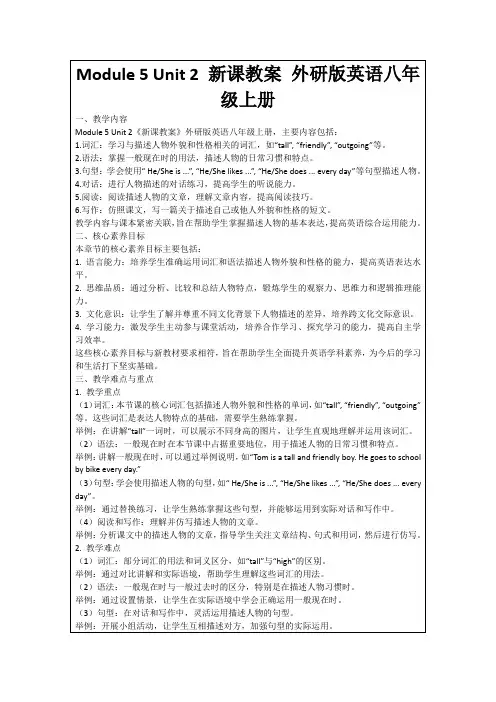
教案Module 11 Way of life.Unit 1 In China ,we open agift later.第49、50课时【学习目标】1、(知识与技能):1. 学习本单元的新词汇及短语,掌握它们的基本含义及用法。
2. 学习理解情态动词can,must ,need,can’t,mustn’t,needn’t的用法。
2、(过程与方法):通过自主学习和小组合作,能够听懂并描述不同国家生活方式的话题。
3、(情感、态度与价值观)激情投入,阳光展示,了解不同国家的生活方式。
【重点难点】学习重点:Key vocabulary, Key stryctures学习难点:How to enable the students to use new words and infinitives.情态动词can,must,need,c an’t,mustn’t,needn’t的用法。
【学法指导】课前在熟读单词与短文的基础上认真完成自主学习内容并能把重点单词短语熟记于Module 11 Way of life.Unit2 In England, you usuallydrink tea with milk.第51、52课时【学习目标】1、(知识与技能):掌握本单元的重点词汇短语、句型。
2、(过程与方法):通过阅读文章及小组合作,学会理解文章大意和提取细节信息的方法。
3、(情感、态度与价值观)能了解一些英国的传统习俗,在短文中获取有效信息。
让学生了解不同的国家有不同的传统习惯,要尊重文化差异。
【重点难点】学习重点:Key vocabulary, Key stryctures学习难点:How to enable the students to use new words and infinitives.情态动词can,must,need,can’t,mustn’t,needn’t的用法。
【学法指导】课前在熟读单词与短文的基础上认真完成自主学习内容并能把重点单词短语熟记于Module 11 Way of life.Unit 3 Language in use.第53课时【学习目标】1、记住M11的单词和短语,并归纳can , can’t , must , mustn’t , needn’t的用法。
Module 7 A famous storyUnit 1 Alice was sitting with her sister by the river一、学习目标:A.单词和短语:fall, follow, hole, rabbit, ssh, ground, teaparty, twice, once or twice, suddenly, pink, pocket, field, think about, deep, while, land, dryB.交际用语:1. Ssh!2. Sorry!3. —What’s the book?—It’s about…4. Why was it running?5. Alice was sitting with her sister by the river.6. It was sitting in a tree and was smiling at everyone.7. They were having a tea party in the garden.8. She was playing a strange game!9. Where was it going?10. To see if you remember the story!11.—The Cheshire Cat was sitting on the grass.—No, it wasn’t. It was sitting in a tree.12. — The white rabbit was looking at its watch.— Yes, it was.13— What were you doing at 5 am yesterday?— I was getting up.二. 教学目标1. Function: Telling a story2. Structure: Past continuous3. Skills:1) Listening and understanding the plot development of Alice’s Adventures inWonderland. Understanding the major characters and events.2) Participating in a role-play with the teacher’s guidance.3) Reading and understanding the sequence of events in Alice’s Adventures in Wonderland.4) Writing a short passage about what happened after Alice fell down the rabbit hole.4. Around the world: Stor ies5. Task: Writing a short story about your own experience.三、重点及难点:Grammar: Past continuous四、教学设计:Unit 1 Alice was sitting with her sister by the river.ⅠTeaching modelListening and speakingⅡTeaching methodPWP approachⅢTeaching aims1. Key vocabulary: fall,follow, hole, rabbit, ssh, ground, teaparty2. Key structures: Past continuous: was / were + v-ingⅣTeaching aidsTape recorder, OHP , videoⅤTeaching StepsStep 1 Warming-up1. Enjoy a play: Alice’s Adventures in Wonderland2. Show some pictures and tell the story:Alice’s Adventures in Wonderland3. Look at the pictures, and talk something about the pictures.4. Introduce the new words.5. Learn the new words.6. Read the new words.Step 2 Listening practice.1. Ask the students to read the words in the box in Activity 1.fall follow hole rabbit strange2. Play the recording once without stopping.3. Listen and underline the correct words.4. Play the recording again and ask the whole class to check with a partner.5. Check the answers:Step 3 Listening practice.1. Ask the students to look at the pictures and read through the sentences in Activity2.2. Play the recording once without stopping.3. Listen and underline the correct words.4. Play the recording again and ask the whole class to check with a partner.5. Check the answers:Step 4 Listen and read.1. Show some pictures, and ask the students to talk about them.2. Ask the students to read the conversation silently.3. Play the recording and ask the students to listen and read the conversation.4. Read the conversation.5. Act it out.6. Learn “Everyday English”1) Ssh!2) Sorry!3)It’s about…Step 5 Complete the sentences.1. Ask the students to read the sentences in the box in Activity 3.2. Read through the sentences.1) Alice was ______ with her ______ by the river.2) The white rabbit with a ______ ran past.3) The Mad Hatter, the March Hareand a mouse were having a ____ party.4) The Queen of Hearts was ______ a strange game.3. Now complete the sentences. Use the words in the box to help you.4. Ask the students tocheck with a partner.5. Check the answers:Keys:1. sitting sister2. watch3. tea4. playingStep 6 Complete the sentences.1. Ask the students to read the words in the box in Activity 4.fall hole smile strange watch2. Read through the sentences.1) Something is ___________ if it is not usual.2) You ___________ when you are happy.3) You can wear a __________. It tells you the time.4) A rabbit ___________ is a place where rabbits live.5) You ___________ when you move down quickly to the ground3. Complete the sentences with the words in the box.4. Ask the students tocheck with a partner.5. Check the answers:Keys: 1. strange 2. smile 3. watch 4. hole 5. fallStep 7 Listen and repeat.1. Play the recording once without stopping.2. Play the re cording again and ask the whole class to repeat.1) —The Cheshire Cat was sitting on the grass.—No, it wasn’t. It was sitting in a tree.2)— The white rabbit was looking at its watch.— Yes, it was.3. Now work in pairs. Listen and repeat.Step 8 Wo rk in pairs.1. Ask the students to read the conversations in Activity 6 aloud.2. Do an interview.Student A: You are a school newspaper reporter. You’re interviewing a school basketball star about what he did yesterday.Student B: You are a star on your school basketball team. A school newspaper reporter is interviewing you.— What were you doing at 5 am yesterday?— I was getting up.3. Work in pairs.Step 9 Grammar一般来说,过去进行时是指“过去的某一时间进行发生的动作或事情”。
备课本外研版八年级上册英语全册教案班级______教师______日期______module 1教案Unit 2教案按住Ctrl键单击鼠标打开配套的视频动画和单词音频朗读mp3播放Unit 3教案Module2教案课后评价教案教案教案教案American scientists have discovered that some plants are able to correct mistakes in their own genetic (遗传的) material.Then show the following and tell students something about the present perfect tense.1. I've just heard the news on the radio about the space mission to Mars.2. I haven't heard about this yet.3. Has it reached Mars yet?T: In these sentences we can find the structure: have / has +pp. Can you find more sentences like these in the passage? We use the Present Perfect to say that an action happened at an unspecified time before now. The exact time is not important.Show the following.EXAMPLES:I have seen that movie twenty times.I think I have met him once before.There have been many earthquakes in California.Has there ever been a war in the United States?People have traveled to the moon.Step III Pronunciation and speakingPlay the recording. Ask students to underline the words the speaker stresses. Then check the answers. Then ask students to read after the recording and repeat the sentences.Step IV Homework1.Ask students to learn the new words and expressions in this unit.2.Ask students to write a short passage to introduce space travel.教案教案Then go through Around the world with students.Step IV Module taskT: Do you know the first Moon landing or China's first manned space travel? Please work in groups and make a poster about space travel. You can look for more photos and information on the Internet.A sample poster:Making History: China's First Human SpaceflightOct. 15, 2003, China launched an astronaut into Earth orbit. Shenzhou V takes offChina Prepares for Second Piloted Space MissionChina Launches Experimental SatelliteStep V Homework1. Ask the students to summarize what they have learned in this unit and preview the next unit.教案课后评价教案教案教案教案教案教案板书设计:过去进行时的构成:…过去进行时的用法:…词组:…课后评价教案教案八年级上册教案。
外研版英语八年级上册Module 6《Animals in danger》(Unit 2)教学设计一. 教材分析《Animals in danger》是人教版英语八年级上册Module 6的第二单元,本节课主要讨论动物保护的问题。
教材通过介绍濒危动物,让学生学会谈论动物的特点以及保护动物的重要性。
内容主要包括对话和阅读材料,对话内容是围绕两个学生在讨论他们最喜欢的动物,并讨论了动物濒危的原因。
阅读材料是一篇关于大熊猫的文章,介绍了大熊猫的生活习性和保护现状。
二. 学情分析八年级的学生已经具备了一定的英语基础,能够进行简单的英语交流。
但他们在阅读和写作方面还存在一定的困难,因此需要教师耐心引导,逐步提高他们的阅读和写作能力。
此外,学生对于动物保护这个话题可能比较感兴趣,因此教师可以利用学生的兴趣,激发他们的学习积极性。
三. 教学目标1.知识目标:学生能够掌握有关动物的词汇和表达方式,如endangered, habitat, protection等;学生能够理解对话和阅读材料的内容,并能够进行简单的交流和讨论。
2.能力目标:学生能够运用所学的词汇和句型进行阅读和写作,提高阅读和写作能力。
3.情感目标:学生能够认识到保护动物的重要性,增强环保意识。
四. 教学重难点1.重点:学生能够掌握有关动物的词汇和表达方式,理解对话和阅读材料的内容。
2.难点:学生能够运用所学的词汇和句型进行阅读和写作,提高阅读和写作能力。
五. 教学方法1.任务型教学法:通过设置各种任务,让学生在完成任务的过程中学习和运用英语。
2.情境教学法:通过创设情境,让学生在真实的环境中学习和运用英语。
3.小组合作学习:通过小组讨论和合作,提高学生的参与度和合作能力。
六. 教学准备1.教师准备教材、教案、课件等教学材料。
2.学生准备课本、笔记本等学习用品。
七. 教学过程1.导入(5分钟)教师通过向学生展示一些濒危动物的图片,引导学生谈论动物保护的话题。
Module 1 How to learn EnglishUnit 1 Let’s try to speak English as much as possible.一、学习目标:A.单词和短语:pair, correct, spelling, word, practice, match, meaning, complete, sentence, dictionary, grammar, letter, look up, mistake, make a mistake, understand-understood, advice, should, possible, write down, notebook, forget-forgot, pronounce, aloud, radio, pronunciation, key, main, excellent, agree, agree with sb., vocabulary, ask for, improve, basic, time, advise, shy, conversation, quickly, natural, suggest, placeB.交际用语:1. Ready?2. That’s a good idea.3. What else?4. Thanks a lot!5. Excellent!6. We should always speak English in class.7. Let’s try to speak English as much as possible.8. Why not write down the mistakes in our notebooks?9. It’s a good idea to s pell and pronounce new words aloud.10. How about listening to the radio?11. It’s better not to translate.12. It’s a good idea to check new words every day.二. 教学目标1. Function: Giving suggestions (English study)2. Structure: Giving advice: 1) We/You sh ould…2) Let’s try to…3) Why not…?4) It’s a good idea to…5) How about…?6) Why don’t we/you…?7) It’s better not to…3. Skills: 1) Listening and understanding familiar topics (English study).2) Talking about problems in English study and giving advice,conductingconversations in several turns.3) Reading and finding specific information about English study.4) Drafting a letter asking for advice about English study, revisingthrough pair discussion..4. Around the world: English online5. Task: Writing your English study plan.三、重点及难点:Giving advice: 1) We/You should…2) Let’s try to…3) Why not…? 4) It’s a good idea to…5) How about…? 6) Why don’t we/you…? 7) It’s better not to…四、教学设计:Unit 1 Let’s try to speak English as much as possible.ⅠTeaching modelListening and speakingⅡTeaching methodPWP approachⅢTeaching aims1. To understand conversations involving advice on learning English.2. To get information about how to learn English from the conversation.3. To understand the way of giving advice.4. To practise giving advice on English learning.ⅣTeaching Objectives1. Key vocabulary: pair, correct, spelling, word, practice, match, meaning,complete, sentence, dictionary, grammar, letter, look up,mistake, make a mistake, understand-understood, advice,should, possible, write down, notebook, forget-forgot,pronounce, aloud, radio, key, main, excellent, agree, agreewith sb., vocabulary2. Key structures: 1) We/You should…2) Let’s try to…3) Why not…? 4) It’s a good idea to…5) How about…? 6) Why don’t we/you…? 7) It’s better not to…ⅤTeaching aidsTape recorder, OHP , videoⅥTeaching StepsStep 1 Warming up1. Show some pictures of school things. Say how to learn English well.2. Read the words after the teacher.3. Introduce the new words.4. Learn the new words.Step 2 Read and check.1. Read the instructions in Activity 1and check(√) the ones you understand.1) Work in pairs. Ask and answer the questions.2) Correct the spelling.3) Listen and check the words you hear.4) Practise saying the words.5) Match the words with the meaning.6) Complete the sentences with the words in the box.3. Ask the students to check their answer with a partner.4. Call back the answer from the whole class and check the answer.Step 3 Listen and repeat.1. Ask the students to read the word and expressions in Activity2. dictionary grammar letter look up make a mistake meaning understand2. Read through the questions.1) Which word did Daming not understand?2) What mistake did Lingling make?3) How does Daming usually check the spelling of a word?4) Why is it difficult for Daming to check the spelling of cinema?3. Play the recording and ask the students to listen to the recording carefully.4. Listen and answer the questions. Use the words and expressions from the box.5. Play the recording again, then they can check their answer with a partner.6. Call back the answer from the whole class and check the answer.Step 4 Listen and read.1. Show some pictures, and ask the students to talk about them.2. Ask the students to read the conversation silently.3. Play the recording and ask the students to listen and read the conversation.4. Read the conversation.5. Act it out.6. Learn “Everyday English”Ready?That’s a good idea.What else?Thanks a lot!Excellent!7. Tell the students how to learn English well.1) We should always speak English in class.2) Let’s try to speak English as much as possible.3) Why not write down the mistakes in our notebooks?4) Don’t forget to write down the correct answers next to the mistakes.5) It’s a good idea to spell and pronounce new words aloud every day.6) How about listening to the radio?7) How about reading English stories?8) W hy don’t we try to find some English pen friends?Step 5 Writing.1. Read the conversation again.2. Ask the students to write notes about learning English.Listening : listen to the radioSpeaking : ___________________________________________________ Reading : ____________________________________________________ Writing: ____________________________________________________ Learning new words: ___________________________________________3. Ask the students to check with a partner.4. Check the answers:Keys:Listening : listen to the radioSpeaking : speak English as much as possibleReading : read an English storiesWriting: write to pen friends, write down our mistakes in our notebooks, write down the correct answers next to the mistakesLearning new words: spell and pronounce new words aloud every dayStep 6 Underline the correct words and expressions.1. Ask the students to read through the passage in Activity 4.Here’s my (1) advice / notebook about learning English. Speak English (2) always / as much as possible in class, and listen to English (3) in the newspaper / on the radio. I (4) agree / forget it’s a good idea to look up n ew worlds in the ( 5) notebook / dictionary. You can find the (6) correct / excellent pronunciation and learn the meaning2. Underline the correct words and expressions.3. Check with a partner.4. Call back the answers from the whole class.Keys: 1. advice 2. as much as possible 3. on the radio 4. agree 5. dictionary 6. correct 5. Read the passage together.Step 7 Listen and repeat.1. Play the recording once without stopping.2. Play the recording again and ask the whole class to repeat.1) We should always speak English in class.2) Let’s try to speak English as much as possible.3) Why not write down the mistakes in our notebooks?4) It’s a good idea to spell and pronounce new words aloud.5) How about listening to the radio?3. Ask the students to listen and mark the intonation.4. Now listen again and repeat.Step 8 Work in pairs.1. Talk about problems and give advice.Problems AdviceI can’t… How / What about …?I don’t know… Why not / don’t you …?2. Read through the example with the class.—I can’t speak English well. What should I do?—Why don’t you try to talk to our classmates in English?3. Work in pairs.Step 9 Important and difficult points1 Why not write down our mistakes in our notebooks?何不在笔记本上把我们的错误记下来?Why not …? 用来表示提出某种建议,而不是询问为什么不做某事的原因,例如:Why not take a walk in the park ?何不在公园里散散步?我们还可以用下面的表达方式来提建议:Why don’t we drive to the country?我们何不开车去乡下?What / How about going to Europe for a holiday?去欧洲度假怎么样?Write down 或者put down 表示“记下,写下”。
外研版八年级英语上册教案
教案标题:Unit 1: My New Teachers
教学目标:
1. 通过本单元的学习,学生将能够熟练运用以下词汇和短语:classroom, grade, subject, timetable, timetable, smart, strict, kind, funny, boring, difficult, easy, interesting, like, dislike, favorite, dislike, enjoy, love, hate, be good at, be bad at, be interested in, be bored with, be tired of, be worried about, be strict with, be kind to, be funny with.
2. 学生能够描述自己的老师并表达对老师的喜好和不喜好。
3. 学生能够询问和回答有关课程、老师和时间表的问题。
4. 学生能够运用一般现在时和一般过去时进行交流。
教学重点:
1. 学习描述老师的外貌、性格和教学方法的词汇和短语。
2. 学习询问和回答关于课程、老师和时间表的问题。
3. 学习运用一般现在时和一般过去时进行交流。
教学准备:
1. 外研版八年级英语上册教材和教学素材。
2. 多媒体设备和投影仪。
3. 学生课本和练习册。
教学过程:
Step 1: Lead-in (引入) (5 minutes)
- 利用图片或视频展示不同类型的老师,引起学生对老师的讨论。
- 引导学生描述老师的外貌和性格特点。
Step 2: Vocabulary Introduction (词汇介绍) (10 minutes)
- 利用多媒体展示相关词汇和短语的图片,帮助学生理解词汇的意思。
- 引导学生朗读并模仿正确的发音和语调。
Step 3: Listening and Speaking (听说训练) (20 minutes)
- 播放录音,让学生听取有关老师的描述并选择正确的图片。
- 学生之间进行配对对话,描述自己喜欢和不喜欢的老师,并给出理由。
Step 4: Grammar Practice (语法练习) (15 minutes)
- 引导学生回顾一般现在时和一般过去时的用法。
- 学生完成一些练习,如填空、改错等,巩固所学的语法知识。
Step 5: Reading and Writing (阅读和写作) (20 minutes)
- 学生阅读课本中关于老师的短文,并回答相关问题。
- 学生根据所给提示写一篇关于自己喜欢的老师的短文。
Step 6: Consolidation and Extension (巩固和拓展) (10 minutes)
- 学生进行小组讨论,分享自己喜欢的老师,并给出理由。
- 学生根据自己的时间表和老师的要求,编写一份自己的时间表。
Step 7: Homework (家庭作业) (5 minutes)
- 要求学生完成练习册中的相关练习,巩固所学的知识。
教学评估:
- 教师观察学生的听说读写能力,及时给予反馈和指导。
- 学生完成课堂练习和作业,检查他们对所学知识的掌握程度。
教学延伸:
- 学生可以通过采访同学和老师,了解更多关于不同老师的信息,并进行口头报告。
- 学生可以设计一个调查问卷,调查同学们对不同老师的喜好和不喜好,并制作一份调查报告。